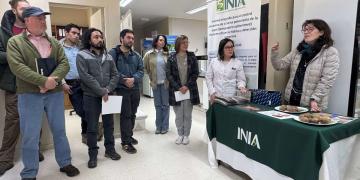EEUU: Idaho grower’s success starts with soil
Brant Darrington farms near Declo, Idaho, in the southern part of the state. Nutrient management and fertilization are important components at Marsh Creek Farms, which plants around 2,000 acres of potatoes annually.

“I am a third-generation potato grower and operate with my brother Brogan and another partner, Kevin Mangum. Collectively, we produce potatoes, sugarbeets, wheat, barley, hay and some corn,” Darrington said.
“We are very focused on soil health and building up our soil. For this purpose, we have a long crop rotation and a healthy compost program. We like the biological organic matter that comes alongside the nutrients, from the compost. It is always applied in the fall so we can work it into the soil.”
Brant Darrington, his brother Brogan Darrington and third partner Kevin Mangum work with agronomist Kaylen Martinez on a third-generation potato farm near Declo, Idaho. All photos courtesy of Brant and Brogan Darrington.
The compost is purchased from local dairies on neighboring farms; this is a good way for the dairies to get rid of their waste material.
Kaylen Martinez, an agronomist and consultant with Valley Agronomics who works closely with Darrington and his partners, says the compost program helps build the soil — not just for potatoes but also for the additional crops.
“We get more organic matter this way, to create healthy soil; it’s a nutrient source for the microbes in the soil, and keeps them thriving,” Martinez said. “This makes the farm less dependent on commercial grade fertilizers, as well. The compost has more lasting benefit. It’s definitely a multiyear program, to see all the benefits.”
FERTILIZER FOCUS
For the potatoes, fields are marked out in the fall and fertilized. Martinez said liquid fertilizer is applied, with the actual blend depending on the results of a soil sample, through the mark out bar, to match the nutrient needs of the soil. In the spring, a dry fertilizer spreader machine is taken down the rows to top dress a portion of the necessary nitrogen and potassium fertilizer before the potatoes are planted.
The soil fertility on a certain piece of ground may vary from season to season, depending on the crop rotation and what was grown there before.
An overhead view of rows of potatoes being tilled
The soil fertility on a certain piece of ground at Marsh Creek Farms may vary from season to season, depending on the crop rotation and what was grown there before.
“We like to rotate potatoes on our neighbor’s ground, as well, to stretch out the rotation on our own ground (and not have to come back so soon again with potatoes),” Darrington said. “It’s rare that we put potatoes in that same field again within five years, and we really prefer six-plus years.”
This ensures that the ground is “fresh” again, without any potato diseases or pests.
“This allows us to get by without using K-PAM or other fumigants,” Martinez said.
The fumigants are generally injected in the fall with the mark out bar prior to planting, primarily to protect yield and prevent losses due to early vine death and reduced tuber quality caused by soilborne pests. Not having to apply fumigants when preparing the soil saves costs and has less adverse impact on the soil biology.
“In the spring we cut our own seed potatoes,” Darrington said. “We treat the seed with Mancozeb or another fungicide, Maxim MZ, depending on the variety of potato and what its needs are. From there, we go to the planter. We plant the seed potatoes, using four Double L six row planters.”
The new planters are more consistent than the older types but are still simple machines, he said.
SEED SOLUTIONS
It is important to make sure the seed potatoes are disease-free, and to handle the seed properly to allow it to have the best chance for a good crop. Darrington uses a rate controller to control the fertilizer that is put down as the potatoes are planted, putting it right next to the seed potato.
“For fertilizer on the planter, we are mainly focusing on phosphorus and zinc,” Martinez said.
tractors wait to plow another row under a sunset of brilliant pink and blue
Marsh Creek Farms, run by Brant Darrington and his growing partners in southern Idaho, employs crop rotation and a compost program to build soil health.
Both nutrients are important for early root development. When the planter comes through, the nitrogen and potassium fertilizer that was already top-dressed prior to planting is mixed into the bed by the planter.
“We also use that rate controller to apply chemical,” Martinez said. “On the chemical side, we treat the soil with a fungicide and insecticide right around the seed piece” for optimum protection.
Just before emergence, the growers run a cultivator and diker to hill up the potatoes.
“We work hard to provide a healthy environment and every opportunity for that little seed piece to thrive,” Darrington said.
Fuente: https://spudman.com/article/idaho-growers-success-starts-with-soil/




